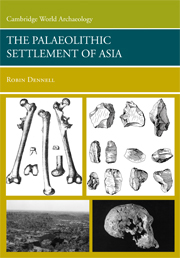Book contents
- Frontmatter
- Contents
- List of Tables, Figures, and Boxes
- Preface
- 1 Asia and Its Place in Palaeoanthropology
- 2 The African Background to the Colonisation of Asia
- 3 The Climatic and Environmental Background to Hominin Settlement in Asia before 1 MA
- 4 The Earliest Inhabitants of Southwest Asia
- 5 The Earliest Inhabitants of South and Southeast Asia and China
- 6 “Out of Africa 1” Reconsidered and the Earliest Colonisation of Asia
- 7 The Climatic and Environmental Background to Hominin Settlement in Asia between ca. 1 Ma and the Last Interglacial
- 8 The Middle Pleistocene Archaeological Record for Southwest and Central Asia
- 9 The Middle Pleistocene Archaeological Record of the Indian Subcontinent
- 10 The Middle Pleistocene Archaeological Record of China and Southeast Asia
- 11 Human Evolution in Asia during the Middle Pleistocene
- 12 Concluding Remarks
- Appendix 1 The Sizes of Countries and Regions in Asia, with Comparative Examples
- Appendix 2 Geographical Coordinates of Principal Early Palaeolithic Sites in Asia
- Appendix 3 Geographical Coordinates of Geological Sections and Cores
- Appendix 4 English Names of Various Mammals Recorded in Asia
- Bibliography
- Index
12 - Concluding Remarks
Published online by Cambridge University Press: 05 June 2012
- Frontmatter
- Contents
- List of Tables, Figures, and Boxes
- Preface
- 1 Asia and Its Place in Palaeoanthropology
- 2 The African Background to the Colonisation of Asia
- 3 The Climatic and Environmental Background to Hominin Settlement in Asia before 1 MA
- 4 The Earliest Inhabitants of Southwest Asia
- 5 The Earliest Inhabitants of South and Southeast Asia and China
- 6 “Out of Africa 1” Reconsidered and the Earliest Colonisation of Asia
- 7 The Climatic and Environmental Background to Hominin Settlement in Asia between ca. 1 Ma and the Last Interglacial
- 8 The Middle Pleistocene Archaeological Record for Southwest and Central Asia
- 9 The Middle Pleistocene Archaeological Record of the Indian Subcontinent
- 10 The Middle Pleistocene Archaeological Record of China and Southeast Asia
- 11 Human Evolution in Asia during the Middle Pleistocene
- 12 Concluding Remarks
- Appendix 1 The Sizes of Countries and Regions in Asia, with Comparative Examples
- Appendix 2 Geographical Coordinates of Principal Early Palaeolithic Sites in Asia
- Appendix 3 Geographical Coordinates of Geological Sections and Cores
- Appendix 4 English Names of Various Mammals Recorded in Asia
- Bibliography
- Index
Summary
In 1527, the English merchant Robert Thorne presented his monarch with a map that summarised what Europeans then knew about the world outside their own continent (Figure 12.1). As can be seen, it shows a recognisable depiction of the coastlines of Europe, Africa, South America, and Asia, even if the Asian part of Thorne's map embodied a charming mixture of a few landmarks, vast areas of ignorance, and much guesswork, particularly east of India. Although it is easy now to mock the naiviety of this map, it was in 1527 a vivid and state-of-the-art representation of how much Europeans had learnt about the world beyond their own coastlines since the voyages of Columbus only 30 years earlier.
Thorne's map is an appropriate metaphor for our current knowledge about the hominin settlement of Asia before it was colonised by modern humans. Although a future generation will doubtless find amusement in much of what is written today, it may be hoped that it will concede that a basic outline now exists of early Asian prehistory, and some aspects are now understood very well. Despite the many gaps that remain to be filled, an enormous amount has been learnt in the past 30 years about the climatic, environmental, and hominin record of Asia over the past 1.8 million years, and over a much longer period for its climatic and environmental history.
- Type
- Chapter
- Information
- The Palaeolithic Settlement of Asia , pp. 473 - 478Publisher: Cambridge University PressPrint publication year: 2008



